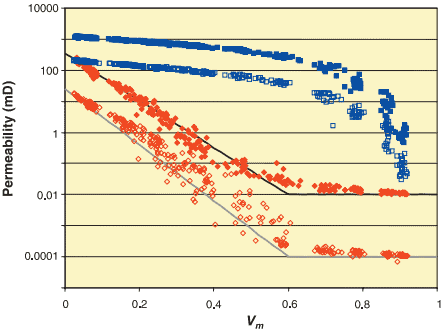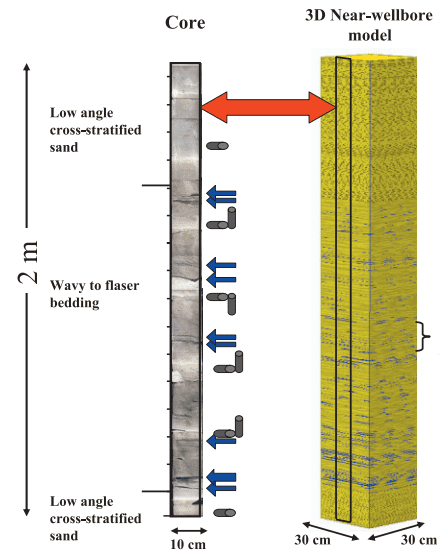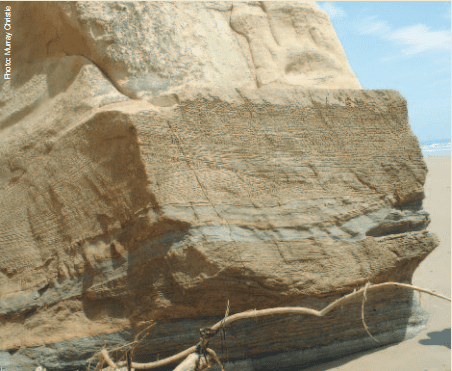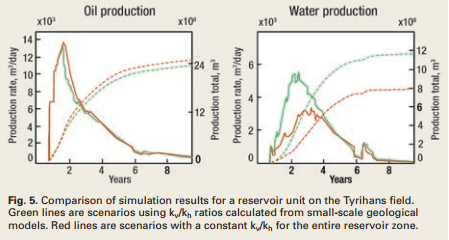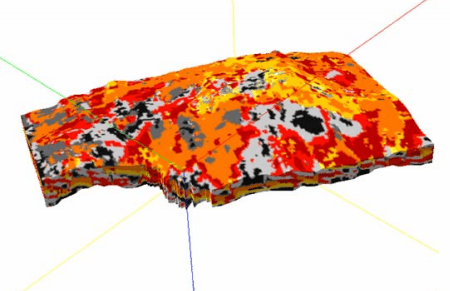A method for estimation of vertical permeability in heterolithic tidal deltaic sandstones is proposed. Three-dimensional, stochastic, process-based models of sedimentary bedding are used to give estimates for the effective permeability of heterolithic tidal sandstone units where heterogeneities in the sandstone and mudstone components are evaluated explicitly. Subsurface core (probe Permeameter)...
Petrophysical characterization of a heterolithic tidal reservoir interval using a process-based modelling tool
Heterolithic lithofacies in the Jurassic Tilje Formation, offshore mid-Norway, consist of three components - sand, silt and mud intercalated at the centimetre scale - and are generally difficult to characterize petrophysically with core and wireline data. A near-wellbore model of the lower part of the Tilje Formation in the Heidrun...
Introducing geological processes in reservoir models
Reservoir modeling and reservoir simulation are based on data collected at multiple scales with resolution ranging from sub-millimeter to tens of meters. New software using knowledge of the geological processes forming the reservoir rock now makes it possible to generate more accurate reservoir models, thereby improving prediction of both production...
Small-scale reservoir modeling tool optimizes recovery offshore Norway
Modeling of small-scale bedding geometries improves recovery estimates in Norwegian oil fields, yielding added value of at least 16 million barrels. Demands for improved oil recovery prompted the Norwegian oil company, Statoil, to evaluate geologically complex oil and gas-condensate fields offshore Norway with a new approach. Here, major sections of...
Vertical Seismic Facies Detection Through Unsupervised 3D Voxel Based Seismic Facies Classification Applied to a Turbidite Field in Campos Basin, Brazil
Nowadays, automatic seismic facies analysis techniques have been growing as an important interpretation tool for the oil exploration industry. Depending on the reservoir knowledge, the seismic facies analysis could be supervised by a priori geological information, or could be unsupervised, when there are not enough data to guide the analysis....
Pore- to Field Scale Multi-Phase Upscaling for IOR
Extending the lifetime and increasing oil recovery of a reservoir requires reliable reservoir simulation models that allow the accurate prediction of production profiles for different IOR strategies. Major ingredients to these simulation models are multi-phase flow parameters, such as relative permeability and capillary pressure, properly adapted to the relevant flow ...
Reservoir challenges of heterolithic tidal sandstone reservoirs in the Halten Terrace, mid-Norway
Production from the Halten Terrace hydrocarbon province (Mid-Norwegian shelf) is mainly from heterolithic siliciclastic successions as well as diagenetically altered sandstones. Eight hydrocarbon fields are currently in production, which produce c. 840 000 BBL oil equivalent per day, with several new fields expected to come on stream in the next decade. This...
Geologically based estimation of kv/kh ratios: an example from the Garn Formation, Tyrihans Field, Mid-Norway
During reservoir model building, one encounters several stages where upscaling or averaging of petrophysical data is required; core plug data have to be compared to wireline measurements and wireline measurements are averaged to the scale of building-size reservoir grid cells. Simple averaging does not, in most cases, give representative values,...
Sequential Simulation With Patterns
Flow in a reservoir is mostly controlled by the connectivity of extreme permeabilities (both high and low) which are generally associated with marked, multiple-scale geological patterns such as fluvial channels. Accurate characterization of such patterns requires multiple-point correlations that are much beyond the reach of the two-point correlations provided by...
A petrophysical evaluation of tidal heterolithic deposits: Application of a near wellbore model for reconciliation of scale dependent well data
The main goal of this thesis, A petrophysical evaluation of tidal heterolithic deposits: application of a near wellbore model for reconciliation of scale dependent well data, is to give a better and less uncertain estimate of porosity and permeability in a challenging reservoir type. This is accomplished through an integrated...

